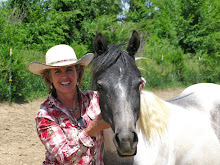Today, there are an estimated 71,000 mustangs; 37,000 of which are living on the HMA’s, another 34,000 are living in government-run corrals and pastures, and over 100,000 wild mustangs have been adopted to date. Why are those 34,000 mustangs living in corrals rather than out on the range, you ask? Good question. Let me explain.
Mustangs reproduce at a rate of 25% per year, so they double their herd size every four years. The BLM land they live on is used for many purposes; livestock, hunting, camping, four wheeling, etc. Most of the HMA’s are located in the West where the vegetation is sparse. In order to maintain “Appropriate Management Levels”, (AMLs – i.e. a designated number of mustangs that the land can support), the BLM conducts “gathers” where they run the herds into holding areas, vet the horses, and then remove a certain percentage of the horses, and release the rest back onto the HMA. The horses that are removed can either be adopted depending on their age and health, or placed in the government-run corrals and pastures. To date, the adoption rate of wild mustangs has not been able to keep up with the number of horses that are removed from the range.
The BLM is in a tight spot. Population increases have increased their budget from $38.8 million in 2007 to $63.9 million in 2010. In 2009, the holding costs for the horses living in long and short-term corrals was $29 million; about 70% of their total budget. What to do?
The Senate Appropriations Committee has deemed that the current path of the Wild Horse and Burro program is not sustainable. Ken Salazar, our Secretary of the Interior, has proposed a new plan.
Here is the link to his new proposal: http://www.blm.gov/wo/st/en/info/newsroom/2009/october/salazar_seeks_congressional.html
Currently the bill is being signed off by the different governmental agencies such as the Department of Agriculture, the Bureau of Land Management before it is presented to Congress. Our Wild Horse and Burro program is at a critical crossroad.
PLEASE READ THE NEXT POST TO FIND OUT HOW TO GET INVOLVED!!




0 comments:
Post a Comment